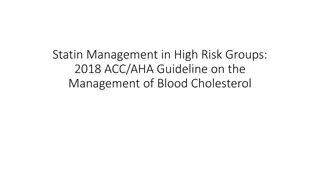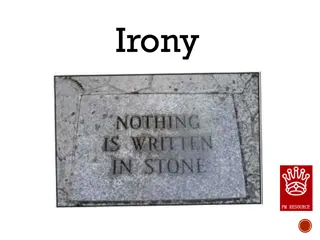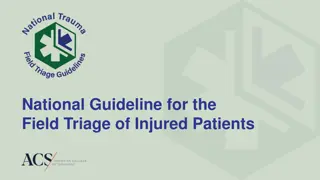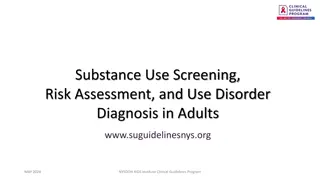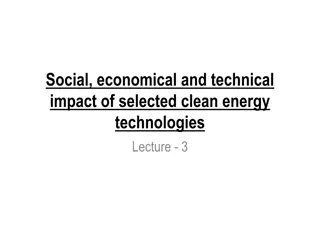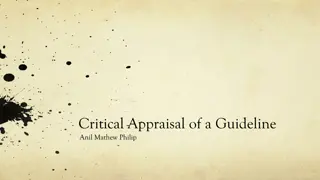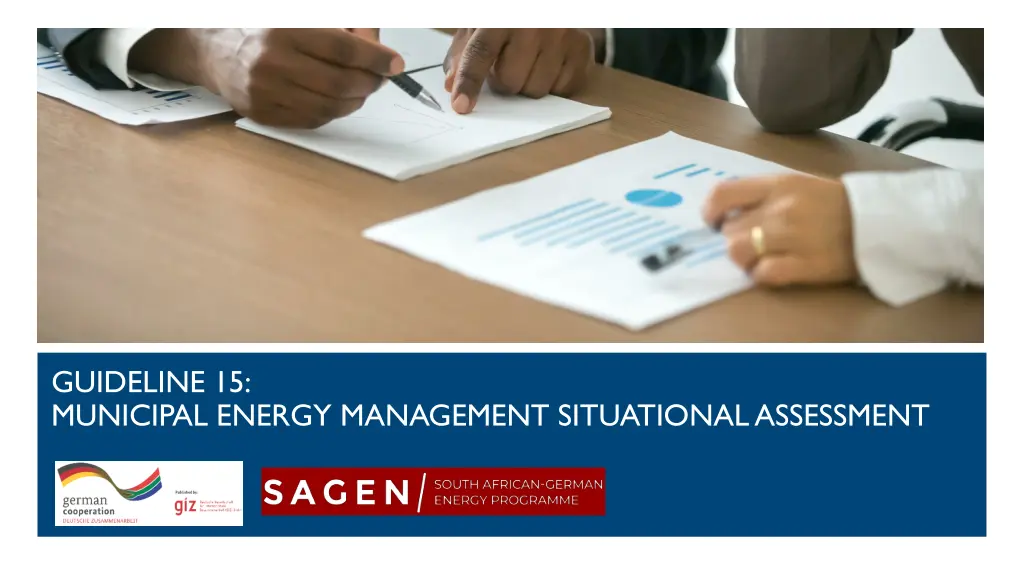
Municipal Energy Management Situational Assessment Guidelines
Explore the purpose and process of conducting a municipal energy management situational assessment in this informative guideline. Understand the importance of assessing a municipality's energy management systems and learn how to improve them for sustainability.
Download Presentation

Please find below an Image/Link to download the presentation.
The content on the website is provided AS IS for your information and personal use only. It may not be sold, licensed, or shared on other websites without obtaining consent from the author. If you encounter any issues during the download, it is possible that the publisher has removed the file from their server.
You are allowed to download the files provided on this website for personal or commercial use, subject to the condition that they are used lawfully. All files are the property of their respective owners.
The content on the website is provided AS IS for your information and personal use only. It may not be sold, licensed, or shared on other websites without obtaining consent from the author.
E N D
Presentation Transcript
GUIDELINE 15: MUNICIPAL ENERGY MANAGEMENT SITUATIONAL ASSESSMENT
2 GUIDELINE 15: MUNICIPAL ENERGY MANAGEMENT SITUATIONAL ASSESSMENT Welcome and thank you for taking the time to read this guideline. This guideline is the 15th in a series of 15 guidelines on different components of a Municipal Energy Management System. This guideline is focused on municipal energy management situational assessments. It covers: What is the purpose of a municipal energy management situation assessment? Using the energy management matrix for a municipal energy management situational assessment How to conduct a municipal energy management situational assessment Municipal Energy Management Systems Programme Guideline Series
MUNICIPAL ENERGY MANAGEMENT SYSTEMS Policy Investment Organisation Energy Management Systems have many components. For this guideline we will be focussing on understanding how a municipality is currently performing with regards to the different components of its energy management systems Implementation Marketing and Communication Skills and Knowledge Information Systems Municipal Energy Management Systems Programme Guideline Series
4 USING THE PLAN-DO- CHECK-ACT CYCLE ISO 50001, the international standard for Energy Management Systems, adopts the Plan-Do-Check-Act Cycle to ensure the continuous improvement of energy management systems. Check Act The PDCA (Plan-Do-Check-Act) Cycle is an iterative four-step management method that is used in many contexts to achieve the continuous improvement of processes. Do Plan Municipal Energy Management Systems Programme Guideline Series
5 IMPLEMENTATION OF ENERGY MANAGEMENT INTERVENTIONS ARE AN ITERATIVE PROCESS Check Do Act Check Plan Do Act Check Plan Do Act Municipal Energy Management Systems Programme Guideline Series Plan
6 WHAT IS THE PURPOSE OF A MUNICIPAL ENERGY MANAGEMENT SITUATION ASSESSMENT? GUIDELINE 15: MUNICIPAL ENERGY MANAGEMENT SITUATIONAL ASSESSMENT Municipal Energy Management Systems Programme Guideline Series
7 WHAT IS AN MUNICIPAL ENERGY MANAGEMENT SITUATIONAL ASSESSMENT? A municipal situational assessment documents the current baseline of a municipality with regards to its energy management system For each component of the municipal energy management system, the assessment articulates how the municipality is currently placed with regards to that component
8 WHAT IS AN ENERGY MANAGEMENT SITUATIONAL ASSESSMENT USED FOR? Understanding the current baseline of a municipality with regards to energy management Identifying the key areas where improvements are required in the municipal energy management system Determining if improvements have been made to the municipal energy management system over time
9 USING THE ENERGY MANAGEMENT MATRIX FOR A MUNICIPAL ENERGY MANAGEMENT SITUATIONAL ASSESSMENT GUIDELINE 15: MUNICIPAL ENERGY MANAGEMENT SITUATIONAL ASSESSMENT Municipal Energy Management Systems Programme Guideline Series
10 WHAT IS THE ENERGY MANAGEMENT MATRIX? It is a tool that can be used to establish the baseline of a municipality s energy management with regards to the seven components of the municipal energy management system It is a matrix that allows for each component of the municipal energy management system to be rated. For each component, the municipality can score between 1 (indicating that work has not yet been initiated in this area) and 5 (the municipality has put in place all the documents, systems and structures to be successful in the area). Municipal Energy Management Systems Programme Guideline Series
11 THE ENERGY MANAGEMENT MATRIX Skills & Knowledge Information Systems Marketing & Communicating Score Policy Organisation Financing Implementation Energy management policy, action plan and regular reviews, with the active commitment of top management EM committee with a formal mandate from management represented by all key departments and dedicated EM post with clear accountability for EM Multi-year EM staff training programme implemented and tailored to identified needs, with evaluation Automated energy information system with alarms for anomalies and comprehensive performance measurement vs targets Extensive and regular communication internally and externally of energy issues reporting on progress towards EM targets Energy cost savings used to leverage additional significant external EM funding opportunities EM targets as set out in the policy successfully achieved 5 Formal EM policy but no active commitment from top management Dedicated EM committee established and clear delegation of all EM responsibilities across key staff Managers receive regular and specific training. Brief awareness training provided to all energy users Energy information based on sub-metering at sites updated semi-automatically & used for monitoring & targeting for interventions Regular internal communication campaigns on EM Energy cost savings used to leverage internal finance for new EM and energy efficiency projects Action plan with annual targets and EM interventions with no direct or long payment periods being implemented 4 Un-adopted EM policy EM discussed regularly at some committees and some formal delegation of EM responsibility for staff Managers receive regular EM training and occasional system-specific training Energy information database updated monthly with accurate site account details that are being used for basic monitoring and targeting Municipal communication mechanisms used to promote energy management Annual internal allocation for low- or medium-cost measures considered if they have a short payback period Detailed action plan with timeframes and budgets and interventions with short payback periods being implemented 3 An unwritten set of guidelines relating to EM Informal responsibility for EM at a staff and committee level Managers participate occasionally in EM training Energy information consists primarily of billing data and is only checked for billing purposes Ad-hoc informal energy management communication with all municipal staff External budget (e.g. EEDSM) used for low- or no-cost interventions Draft EM action plan in place, with some energy audits and some ad-hoc low or no cost interventions No EM action plan and no projects or implementation taking place 2 Municipal Energy Management Systems Programme Guideline Series No explicit EM policy No cross-departmental EM committee or delegation of EM responsibility in staff job descriptions Managers rely on their existing knowledge for EM activities No system for measuring energy costs or consumptions No communication or promotion of energy issues with all municipal staff No internal or external budget used for EM systems or energy efficiency projects 1
12 THE POLICY COMPONENT IS SCORED BY DETERMINING AT WHAT LEVEL THE ENERGY MANAGEMENT POLICY IS SITTING Score 1 Score 2 Score 3 Score 4 Score 5 No explicit energy management policy An unwritten set of guidelines relating to energy management Un-adopted energy management policy Formal energy management policy but no active commitment from top management Energy management policy, action plan and regular reviews, with the active commitment of top management Municipal Energy Management Systems Programme Guideline Series
13 THE ORGANISATION COMPONENT IS SCORED BY DETERMINING AT WHAT LEVEL THE ENERGY MANAGEMENT ORGANISATION IS SITTING Score 1 Score 2 Score 3 Score 4 Score 5 No cross- departmental energy management committee or delegation of energy management responsibility in staff job descriptions Informal responsibility for energy management at a staff and committee level Energy management discussed regularly at some committees and some formal delegation of energy management responsibility for staff Dedicated energy management committee established and clear delegation of all energy management responsibilities across key staff Energy management committee with a formal mandate from management represented by all key departments and dedicated energy management post with clear accountability for energy management Municipal Energy Management Systems Programme Guideline Series
14 THE SKILLS & KNOWLEDGE COMPONENT IS SCORED BY DETERMINING AT WHAT LEVEL THE ENERGY MANAGEMENT TRAINING IS SITTING Score 1 Score 2 Score 3 Score 4 Score 5 Managers rely on their existing knowledge for energy management activities Managers participate occasionally in energy management training Managers receive regular energy management training and occasional system- specific training Managers receive regular and specific training. Brief awareness training provided to all energy users Multi-year energy management staff training programme implemented and tailored to identified needs, with evaluation Municipal Energy Management Systems Programme Guideline Series
15 THE INFORMATION SYSTEMS COMPONENT IS SCORED BY DETERMINING AT WHAT LEVEL THE ENERGY MANAGEMENT INFORMATION SYSTEM IS SITTING Score 1 Score 2 Score 3 Score 4 Score 5 No system for measuring energy costs or consumptions Energy information consists primarily of billing data and is only checked for billing purposes Energy information database updated monthly with accurate site account details that are being used for basic monitoring and targeting Energy information based on sub- metering at sites updated semi- automatically & used for monitoring & targeting for interventions Automated energy information system with alarms for anomalies and comprehensive performance measurement vs targets Municipal Energy Management Systems Programme Guideline Series
16 THE MARKETING & COMMUNICATING COMPONENT IS SCORED BY DETERMINING AT WHAT LEVEL THE ENERGY MANAGEMENT COMMUNICATION IS SITTING Score 1 Score 2 Score 3 Score 4 Score 5 No communication or promotion of energy issues with all municipal staff Ad-hoc informal energy management communication with all municipal staff Municipal communication mechanisms used to promote energy management Regular internal communication campaigns on energy management Extensive and regular communication internally and externally of energy issues reporting on progress towards energy management targets Municipal Energy Management Systems Programme Guideline Series
17 THE FINANCING COMPONENT IS SCORED BY DETERMINING AT WHAT LEVEL THE ENERGY MANAGEMENT FINANCE IS SITTING Score 1 Score 2 Score 3 Score 4 Score 5 No internal or external budget used for energy management systems or energy efficiency projects External budget energy management used for low- or no-cost interventions Annual internal allocation for low- or medium-cost measures considered if they have a short payback period Energy cost savings used to leverage internal finance for new energy management and energy efficiency projects Energy cost savings used to leverage additional significant external energy management funding opportunities Municipal Energy Management Systems Programme Guideline Series
18 THE IMPLEMENTATION COMPONENT IS SCORED BY DETERMINING AT WHAT LEVEL THE ENERGY MANAGEMENT ACTION PLAN IS SITTING Score 1 Score 2 Score 3 Score 4 Score 5 No energy management action plan and no projects or implementation taking place Draft energy management action plan in place, with some energy audits and some ad-hoc low or no cost interventions Detailed action plan with timeframes and budgets and interventions with short payback periods being implemented Action plan with annual targets and energy management interventions with no direct or long payment periods being implemented Energy management targets as set out in the policy successfully achieved Municipal Energy Management Systems Programme Guideline Series
19 HOW TO CONDUCT A MUNICIPAL ENERGY MANAGEMENT SITUATIONAL ASSESSMENT GUIDELINE 15: MUNICIPAL ENERGY MANAGEMENT SITUATIONAL ASSESSMENT Municipal Energy Management Systems Programme Guideline Series
20 AN ENERGY SITUATIONAL ASSESSMENT TYPICALLY HAS THREE MAIN STEPS Step 1 Undertake a desktop review of the energy management systems of the municipality Step 2 Host a workshop with key energy management stakeholders to secure their views on the current baseline of the municipality with regards to energy management Step 3 Compile a situational assessment detailing the information from the previous two steps
21 STEP 1: UNDERTAKE A DESKTOP REVIEW OF THE ENERGY MANAGEMENT SYSTEMS OF THE MUNICIPALITY Key elements of a desktop review are: Sourcing and reviewing existing documents on energy management in the municipality such as policies and reports Sourcing and reviewing existing energy management information systems in the municipality Municipal Energy Management Systems Programme Guideline Series
22 STEP 2: HOST A WORKSHOP WITH KEY ENERGY MANAGEMENT STAKEHOLDERS Key activities involved in setting up and running the workshop are Identifying key stakeholders that should participate Preparing a presentation on the results of the desktop review Following a presentation per component of the municipal energy management system, ask participants to give their views of the score of the municipality per component and their reason for the score Municipal Energy Management Systems Programme Guideline Series
23 STEP 3: COMPILE A SITUATIONAL ASSESSMENT DETAILING THE INFORMATION FROM THE PREVIOUS TWO STEPS Key activities involved in compiling the situational assessment are Detailing in the report the results of the desktop review Detailing in the report the results of the stakeholder workshop Concluding the report with a scoring of the municipality against the energy management matrix Municipal Energy Management Systems Programme Guideline Series
24 EXAMPLE OF A MUNICIPAL SCORE AGAINST THE MATRIX Skills & Knowledge Information Systems Marketing & Communicating Score Policy Organisation Financing Implementation Energy management policy, action plan and regular reviews, with the active commitment of top management EM committee with a formal mandate from management represented by all key departments and dedicated EM post with clear accountability for EM Multi-year EM staff training programme implemented and tailored to identified needs, with evaluation Automated energy information system with alarms for anomalies and comprehensive performance measurement vs targets Extensive and regular communication internally and externally of energy issues reporting on progress towards EM targets Energy cost savings used to leverage additional significant external EM funding opportunities EM targets as set out in the policy successfully achieved 5 Formal EM policy but no active commitment from top management Dedicated EM committee established and clear delegation of all EM responsibilities across key staff Managers receive regular and specific training. Brief awareness training provided to all energy users Energy information based on sub-metering at sites updated semi-automatically & used for monitoring & targeting for interventions Regular internal communication campaigns on EM Energy cost savings used to leverage internal finance for new EM and energy efficiency projects Action plan with annual targets and EM interventions with no direct or long payment periods being implemented 4 Un-adopted EM policy EM discussed regularly at some committees and some formal delegation of EM responsibility for staff Managers receive regular EM training and occasional system-specific training Energy information database updated monthly with accurate site account details that are being used for basic monitoring and targeting Municipal communication mechanisms used to promote energy management Annual internal allocation for low- or medium-cost measures considered if they have a short payback period Detailed action plan with timeframes and budgets and interventions with short payback periods being implemented 3 An unwritten set of guidelines relating to EM Informal responsibility for EM at a staff and committee level Managers participate occasionally in EM training Energy information consists primarily of billing data and is only checked for billing purposes Ad-hoc informal energy management communication with all municipal staff External budget (e.g. EEDSM) used for low- or no-cost interventions Draft EM action plan in place, with some energy audits and some ad-hoc low or no cost interventions No EM action plan and no projects or implementation taking place 2 Municipal Energy Management Systems Programme Guideline Series No explicit EM policy No cross-departmental EM committee or delegation of EM responsibility in staff job descriptions Managers rely on their existing knowledge for EM activities No system for measuring energy costs or consumptions No communication or promotion of energy issues with all municipal staff No internal or external budget used for EM systems or energy efficiency projects 1
25 WHAT DOES THE EXAMPLE SCORE TELL US ABOUT THE NEXT STEPS FOR ENERGY MANAGEMENT? While the baseline for the Organisation, Marketing & Communicating, Financing and Implementation components is better than other components, work can still be done to improve performance The most urgent actions to improve this municipality s energy management system are in the Information Systems component The component that performs mostly strongly is the Policy component and it requires the least attention The component that requires the next most attention is Skills & Knowledge Skills & Knowledge Information Systems Marketing & Communicating Score Policy Organisation Financing Implementation 5 4 3 Municipal Energy Management Systems Programme Guideline Series 2 1
26 SEE OTHER GUIDELINES Municipal Energy Management Systems Programme Guideline Series
27 CLICK ON THE BLOCKS BELOW TO SEE OTHER GUIDELINES IN THE SERIES 1 8 9 Developing a municipal energy policy Developing a municipal energy policy Developing a municipal energy policy Developing an Energy Intervention Concept Note Developing an Energy Intervention Concept Note Energy Management Procurement Considerations Energy Management Procurement Considerations Developing a municipal energy policy Developing an Energy Intervention Concept Note Energy Management Procurement Considerations Developing a municipal energy policy Developing an Energy Intervention Concept Note Energy Management Procurement Considerations Establishing an energy management committee 2 7 10 15 Municipal Energy Management Matrix and Initial Assessment Municipal Energy Management Matrix and Initial Assessment Establishing an energy management committee Establishing an energy management committee Implementing energy conservation interventions Implementing energy conservation interventions Energy Management Action Plan Development Energy Management Action Plan Development Municipal Energy Management Matrix and Initial Assessment Establishing an energy management committee Implementing energy conservation interventions Energy Management Action Plan Development Municipal Energy Management Matrix and Initial Assessment Establishing an energy management committee Implementing energy conservation interventions Energy Management Action Plan Development Municipal Energy Management Matrix and Initial Assessment 6 3 14 11 Energy Management in Water and Sanitation Silulumanzi Lessons Energy Management in Water and Sanitation Silulumanzi Lessons Ensuring appropriate energy management skills knowledge Ensuring appropriate energy management skills & knowledge Prioritising Energy Management Interventions Prioritising Energy Management Interventions Investing in energy conservation Investing in energy conservation Energy Management in Water and Sanitation Silulumanzi Lessons Ensuring appropriate energy management skills knowledge Prioritising Energy Management Interventions Investing in energy conservation Energy Management in Water and Sanitation Silulumanzi Lessons Ensuring appropriate energy management skills knowledge Prioritising Energy Management Interventions Energy Management in Water and Sanitation Silulumanzi Lessons 4 Marketing and communicating energy-related information 5 12 13 Municipal Energy Management Systems Programme Guideline Series Marketing and communicating energy-related information Marketing and communicating energy-related information Checking the Success of an Implemented Energy Intervention Checking the Success of an Implemented Energy Intervention Establishing energy information systems Establishing energy information systems The Role of Energy Audits The Role of Energy Audits Marketing and communicating energy-related information Checking the Success of an Implemented Energy Intervention Establishing energy information systems Marketing and communicating energy-related information The Role of Energy Audits Checking the Success of an Implemented Energy Intervention Marketing and communicating energy-related information Checking the Success of an Implemented Energy Intervention









